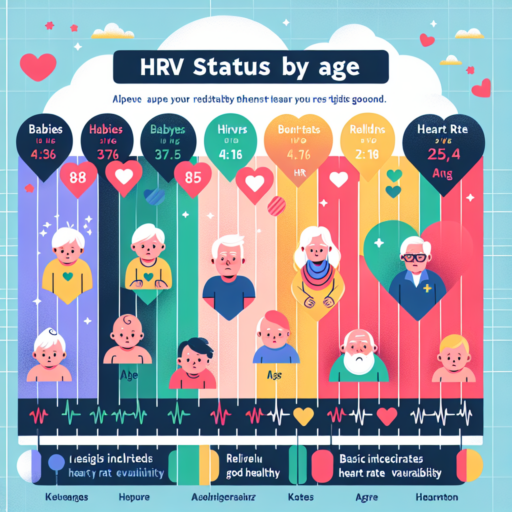Understanding Anaerobic Heart Rate: A Comprehensive Guide
The concept of anaerobic heart rate is crucial for athletes and fitness enthusiasts aiming to maximize their workout efficacy. Unlike aerobic exercises that rely on oxygen, anaerobic activities involve short bursts of high-intensity workouts where the body’s demand for oxygen surpasses the oxygen supply available. This threshold is not only pivotal for improving performance but also for boosting cardiovascular resilience.
Identifying your anaerobic heart rate is a step towards optimizing your training regimen. It is generally recognized when you reach 80-90% of your maximum heart rate. At this juncture, your body starts to produce lactic acid as a byproduct of energy production, signifying that you’ve entered the anaerobic zone. This is where understanding and monitoring your heart rate becomes a tool for pushing your limits appropriately without risking overexertion.
To effectively tap into the benefits of anaerobic training, incorporating heart rate monitoring techniques can be invaluable. Utilizing gadgets like heart rate monitors or smartwatches during exercises can help you stay within your anaerobic zone, allowing for maximum efficiency in your training sessions. This targeted approach ensures that every workout pushes you closer to your fitness goals while maintaining safety and preventing burnout.
How to Calculate Your Anaerobic Heart Rate Zone
Understanding your anaerobic heart rate zone is pivotal for those looking to optimize their high-intensity workout regimes. This specific heart rate zone surpasses the aerobic threshold, tapping into a level of exertion where your body relies on energy sources stored within muscles, rather than oxygen. Calculating this zone accurately can significantly enhance your training outcomes by ensuring you’re working out at the optimal intensity for anaerobic benefits.
To begin calculating your anaerobic heart rate zone, you’ll first need to determine your maximum heart rate (MHR). A common method to achieve this is by subtracting your age from 220. For example, a 30-year-old would have an estimated MHR of 190 beats per minute (bpm). It’s important to note, however, that this is a generalized formula and individual differences can vary. For a more precise reading, consider a supervised test conducted by a fitness professional.
Identifying Your Anaerobic Heart Rate Zone
Once you have your MHR, the anaerobic heart rate zone is typically identified as 80% to 90% of your MHR. Using a calculator or a simple manual calculation, you can pinpoint this zone. For a 30-year-old with a MHR of 190 bpm, the anaerobic zone would range from 152 bpm (80% of MHR) to 171 bpm (90% of MHR). This is the heart rate window where your workouts will primarily produce energy anaerobically.
Understanding and applying this information to your training can transform your fitness routine. By ensuring your heart rate falls within this calculated anaerobic zone during intense workouts, you can efficiently target the improvement of your anaerobic capacity. This zone pushes you just outside your comfort level, optimizing the benefits of each session without overexertion.
The Importance of Knowing Your Anaerobic Heart Rate for Training
Understanding your anaerobic heart rate is crucial for optimizing your athletic performance and ensuring your training is both effective and efficient. This specific heart rate zone, which signifies the threshold at which your body shifts from aerobic to anaerobic metabolism, is pivotal for athletes aiming to increase their endurance, speed, and overall fitness levels. By pinpointing this vital metric, individuals can tailor their workouts to precisely engage and develop their anaerobic capacity, leading to significant improvements in their physical capabilities.
Training at or slightly above your anaerobic threshold can enhance your body’s ability to deal with lactic acid, thereby increasing your stamina and delaying fatigue. This is especially beneficial for endurance sports where maintaining a high level of performance over time is essential. Furthermore, structured training around your anaerobic heart rate can aid in faster recovery, as it conditions your body to more efficiently remove lactic acid from your muscles.
Moreover, knowledge of your anaerobic heart rate enables a more personalized training approach. Every athlete’s body responds differently to exercise, meaning that a one-size-fits-all training program may not be the most effective method for improving anaerobic fitness. By focusing on your unique heart rate zones, you can ensure that each workout is tailored to your body’s specific needs, fostering optimal growth and diminishing the risk of overtraining or injury.
Comparing Aerobic and Anaerobic Heart Rate Zones
Understanding the difference between aerobic and anaerobic heart rate zones is crucial for anyone looking to optimize their fitness routine or enhance athletic performance. The heart rate zone in which you exercise can significantly influence the kind of results you see, whether your goal is to improve cardiovascular health, increase endurance, or build muscle.
Aerobic Heart Rate Zone
The aerobic heart rate zone is often referred to as the fat-burning zone. This zone is typically defined as 70-80% of your maximum heart rate. Exercising in this zone means your body is primarily using oxygen to generate energy, making it ideal for improving cardiovascular fitness and endurance. Activities such as jogging, cycling, and swimming usually keep your heart rate within this zone, enhancing stamina and promoting efficient energy use over longer periods.
Anaerobic Heart Rate Zone
On the other hand, the anaerobic heart rate zone pushes beyond the aerobic zone, often above 80% of your maximum heart rate. This higher-intensity training zone sees your body working without enough oxygen to fuel the demand, which causes your body to start breaking down glucose for energy. This process, not only boosts strength and muscle mass but also enhances your body’s ability to store and utilize energy more efficiently during short bursts of high-intensity activity. Common anaerobic exercises include sprinting, heavy lifting, and high-intensity interval training (HIIT).
Tools and Technology for Monitoring Your Anaerobic Heart Rate
Understanding and monitoring your anaerobic heart rate is crucial for optimizing your high-intensity training sessions. This specific heart rate zone is where the most significant athletic improvements can occur, but tracking it accurately requires the right set of tools and technology. There are several market-leading options designed to give athletes, fitness enthusiasts, and coaches precise insights into this critical data.
Wearable Heart Rate Monitors
At the forefront of anaerobic heart rate monitoring technology are wearable heart rate monitors. These devices, which can be worn as chest straps or wristbands, offer real-time heart rate data. They are engineered to be both comfortable and accurate, ensuring that users can focus on their workout without disruption. Popular brands have developed proprietary algorithms to precisely measure heart rate, even during intense physical activity, making them indispensable tools for anyone looking to optimize their anaerobic training.
Smartphone Apps and Fitness Trackers
In tandem with wearables, smartphone apps and integrated fitness trackers offer a comprehensive view of your physical activity and heart rate zones. Many of these apps are designed to work seamlessly with wearable devices, enhancing their functionality by providing detailed analytics and personalized reports. This synergy between apps and wearables empowers users with a deeper understanding of their anaerobic heart rate patterns, contributing to more targeted and effective workout regimes.
Advanced Sports Watches
Another vital tool in the arsenal for monitoring anaerobic heart rate is the advanced sports watch. Today’s sports watches go far beyond merely telling time, incorporating GPS tracking, heart rate monitoring, and detailed analytics about workout intensity. The high accuracy and convenience of having all these features on your wrist make sports watches especially appealing to serious athletes and fitness aficionados looking to push their limits in anaerobic training.
Exercises to Improve Your Anaerobic Capacity
Enhancing your anaerobic capacity is crucial for athletes and fitness enthusiasts looking to improve their performance in high-intensity sports or activities. This form of exercise involves short, intense bursts of physical activity that push your body to its limits. Fortunately, there are specific workouts that can help you increase your anaerobic threshold and make you more efficient in these demanding situations.
High-Intensity Interval Training (HIIT)
High-Intensity Interval Training, or HIIT, is a cornerstone workout for boosting anaerobic capacity. HIIT combines short, maximum effort activities with brief recovery periods. This setup not only improves anaerobic endurance but also contributes to better cardiovascular health. Incorporating exercises like sprints, bicycle sprints, or burpees in a HIIT routine can significantly enhance your anaerobic capability, making these exercises ideal for those looking to push their limits.
Weightlifting
Though often associated with muscular strength and hypertrophy, weightlifting can also be an effective way to improve your anaerobic capacity. By focusing on compound movements such as deadlifts, squats, and bench presses with heavier weights and fewer repetitions, you engage in a form of high-intensity training that taxes your anaerobic system. This approach not only strengthens muscles but also builds up your ability to perform well in activities that require short, intense bursts of energy.
By incorporating these exercises into your workout routine, you can significantly enhance your anaerobic capacity. Remember, the key to improvement lies in the consistency and intensity of your efforts. As you challenge your body with these high-intensity workouts, you’ll likely notice substantial gains in your overall performance and endurance in anaerobic activities.
Optimizing Performance: Training Within Your Anaerobic Heart Rate Zone
Training within your anaerobic heart rate zone can significantly optimize your physical performance by enhancing both your endurance and speed. This targeted exercise approach focuses on pushing the boundaries of your heart rate to improve athletic capabilities. When you train in this specific zone, you’re essentially teaching your body to become more efficient at dealing with lactic acid, thus delaying fatigue and improving your overall performance.
Understanding your anaerobic threshold is crucial for this type of training. This threshold is the point at which your body starts to produce lactic acid faster than it can clear it. Various methods can be used to identify your anaerobic heart rate zone, including lactate threshold tests, VO2 max tests, and using heart rate monitors during high-intensity intervals. Training just below or right at your anaerobic threshold will help maximize the benefits of your workouts, improving your body’s ability to clear lactic acid and extending the time you can train at high intensities.
Incorporating interval training sessions that elevate your heart rate into the anaerobic zone is a key component of optimizing your performance. These sessions could include short bursts of high-intensity exercise followed by periods of low-intensity exercise or rest. It’s important to monitor your heart rate throughout the workout to ensure you’re training within the correct zone. This approach not only boosts your cardiovascular health but also increases the efficiency of your energy systems, helping you to push harder and longer during your training sessions and competitive events.
Real-Life Applications: When Does Your Body Enter the Anaerobic Zone?
Understanding when your body enters the anaerobic zone is pivotal in optimizing your fitness regime and pushing your limits safely. This transition is not just a random occurrence; it happens under specific conditions that occur in our daily activities and training sessions. Recognizing these moments can empower us to harness the full potential of our workouts and better manage our energy resources.
High-Intensity Interval Training (HIIT)
One of the most common scenarios where you thrust your body into the anaerobic zone is during High-Intensity Interval Training (HIIT). These workouts are designed to elevate your heart rate quickly, using short bursts of very intense activity followed by periods of rest or lower-intensity exercise. When performing exercises like sprinting, heavy lifting, or intense cycling, your body seeks immediate energy sources, transitioning into the anaerobic zone as it cannot oxygenate the muscles fast enough to meet the demands.
Competitive Sports
Competitive sports activities are another real-life application where individuals frequently enter the anaerobic zone. Sports such as soccer, basketball, and tennis involve sudden, explosive movements and sprints that exceed the body’s aerobic capacity. During these high-intensity phases, the body operates anaerobically to provide quick energy, emphasizing why athletes train in both aerobic and anaerobic capacities.
By recognizing these real-life applications, individuals can consciously incorporate and vary anaerobic and aerobic training in their routines, leading to improved endurance, strength, and overall health. This awareness also aids in understanding the body’s responses to different physical demands and optimizing performance across a variety of activities.
Understanding the Risks: When Anaerobic Heart Rates Can Be Dangerous
Engaging in intense physical activities pushes the body into the anaerobic zone, a state where the heart rate soars to high levels, indicating that the body is using more oxygen than it’s taking in. This phase of exercise is crucial for improving endurance and strength. However, understanding the risks associated with anaerobic heart rates is vital to safeguard health and prevent potential dangers.
When the body surpasses the aerobic threshold and enters the anaerobic zone, typically above 80% of an individual’s maximum heart rate, it begins to rely on stored energy sources in the absence of sufficient oxygen. While short bursts into this zone can be beneficial, prolonged periods or frequent episodes without adequate recovery can lead to heart strain, abnormal rhythms, and in extreme cases, cardiovascular complications. Recognizing the signs of overexertion, such as dizziness, unusual shortness of breath, or palpitations, is crucial.
Moreover, individuals with pre-existing heart conditions or those who are new to exercise should be particularly cautious. Engaging in activities that elevate heart rates to anaerobic levels without prior medical consultation can increase the risk of adverse events. It is recommended that those individuals gradually increase their exercise intensity under professional guidance to ensure safety.
No se han encontrado productos.
Frequently Asked Questions About Anaerobic Heart Rate
Understanding your anaerobic heart rate is crucial for optimizing your workout routine and enhancing your overall fitness. This threshold plays a significant role in determining the intensity at which your body starts to burn glycogen without oxygen, making it a key area of interest for athletes and fitness enthusiasts alike. As numerous questions surround this topic, we’re here to provide clarity and help you grasp the significance of your anaerobic heart rate.
What Defines Anaerobic Heart Rate?
The anaerobic heart rate is defined as the point during exercise at which your body shifts from aerobic to anaerobic metabolism, meaning it starts to primarily use glycogen as a fuel source in the absence of oxygen. Identifying this threshold can significantly impact your training by allowing you to tailor your workouts to either stay in the aerobic zone for endurance training or cross into the anaerobic zone to improve high-intensity performance.
How Can You Calculate Your Anaerobic Heart Rate?
Calculating your anaerobic heart rate involves a few steps and can be done with the help of fitness professionals or specific tests, such as the lactic threshold test. It often involves high-intensity exercises that gradually increase in intensity while monitoring your heart rate, until it reaches a level that can no longer sustain aerobic metabolism, indicating you’ve hit your anaerobic threshold. For a more simplified approach, certain formulas based on maximum heart rate calculations can provide an estimate, but these may not be as accurate as personalized tests.




